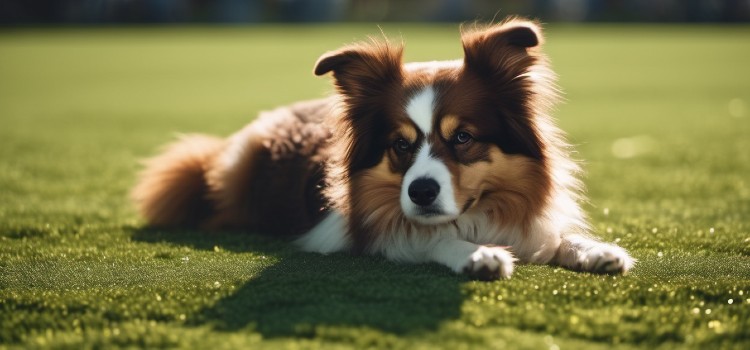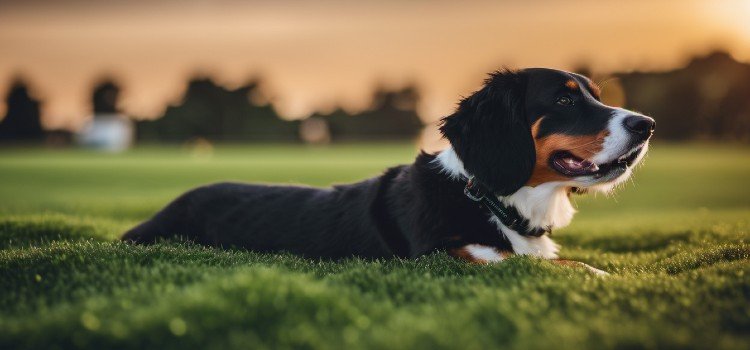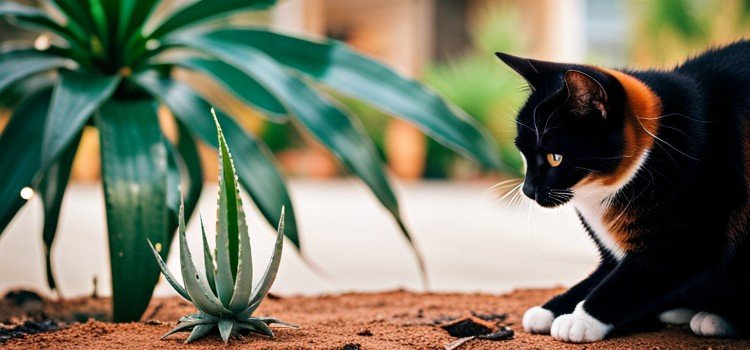As an Amazon Associate committed to the mission of improving the lives of our readers, Live-Clear.com receives a small commission from eligible purchases made through our affiliate links. This revenue enables us to keep producing insightful articles and other material.
Turf can get too hot for dogs, potentially causing burns and discomfort. It’s crucial to monitor the temperature of the turf, especially during peak sun hours.
The well-being of our furry friends is a top priority for pet owners, and ensuring their safety and comfort in outdoor spaces is essential. Many pet owners opt for artificial turf as a low-maintenance alternative to natural grass. However, concerns about the surface temperature of turf and its impact on dogs have arisen.

We will explore the potential risks of hot turf for dogs and provide practical tips to mitigate the heat-related issues. By understanding the factors that contribute to turf heat and implementing suitable precautions, pet owners can create a safer and more enjoyable outdoor environment for their beloved canine companions.
Understanding The Heat Dynamics
When it comes to ensuring the safety and well-being of our furry friends, it is crucial to understand the heat dynamics of turf and how it affects our canine companions. Dogs can be particularly vulnerable to extreme temperatures, and with artificial turf becoming a popular choice for pet owners, it’s important to delve into the nuances of turf temperature and its impact on our canine friends.
How Does Turf Temperature Affect Dogs?
The temperature of the turf surface can significantly impact dogs, especially those spending prolonged periods outdoors. High temperatures can result in discomfort, heat stress, and potential burn injuries to their paws. Understanding the implications of turf temperature on dogs is essential for responsible pet ownership.
Factors Contributing To The Turf’s Heat Retention
Several factors contribute to the heat retention of turf surfaces, including sun exposure, color of the turf, material composition, and thermal conductivity. These elements collectively influence the extent to which the turf absorbs and retains heat, directly impacting the surface temperature experienced by our furry companions.
Signs Of Discomfort In Dogs
Recognizing the signs of discomfort in dogs is crucial, especially when they are exposed to high temperatures on turf. By being attentive to your dog’s behavior and physical cues, you can help prevent heat-related distress and ensure their well-being.
Identifying Heat-related Distress In Canines
When dogs are exposed to excessive heat on turf, they may exhibit various signs of distress. It’s important to be aware of these indicators to take prompt action to prevent potential heatstroke and other heat-related issues. Some common signs of heat-related distress in dogs include:
- Rapid or excessive panting.
- Difficulty breathing.
- Lethargy or weakness.
- Excessive drooling.
- Dark red gums or tongue.
- Vomiting or diarrhea.
- Unsteadiness or collapse.
Behavioral Cues Indicating Overheating On Turf
Observing your dog’s behavior while on turf can provide valuable insights into their comfort level. Certain behavioral cues may indicate that your dog is overheating on turf and needs immediate attention. Watch out for the following behavioral signs of overheating in dogs:
- Seeking shade or attempting to dig for cooler ground.
- Restlessness or inability to settle down.
- Paw licking or lifting legs frequently.
- Refusal to walk or play.
- Excessive water consumption.
- Agitation or confusion.

Impact Of Hot Turf On Dog Health
Turf can become excessively hot for dogs, leading to potential health risks. The high temperatures can cause burns on paws and overheat dogs, impacting their well-being. It’s important to take precautions such as walking dogs during cooler times to ensure their safety.
Impact of Hot Turf on Dog Health Many dog owners are increasingly concerned about the impact of hot turf on their pet’s health. The scorching heat from the turf can have adverse effects on a dog’s well-being, especially when they spend prolonged periods on it. Understanding the paw pad sensitivity and the health risks associated with prolonged exposure is crucial in ensuring our furry friends stay safe and healthy.
Health Risks Associated With Prolonged Exposure
Prolonged exposure of dogs to hot turf can lead to various health issues. Some common health risks include:
- Dehydration.
- Heatstroke.
- Burns on paw pads.
- Discomfort and pain.
Dehydration is a significant concern when dogs are exposed to excessively hot turf. It can lead to serious health complications and discomfort for the pet. Heatstroke is another critical risk, as dogs can easily overheat when the turf temperature rises to excessive levels. The sensitive paw pads of dogs are particularly vulnerable to burns on hot surfaces. This can cause immense pain and discomfort for the animals.
Understanding The Paw Pad Sensitivity
Dogs’ paw pads are designed to provide traction and cushioning, but they are also sensitive to temperature and surface conditions. The paw pads can easily suffer from burns and blisters when exposed to hot turf for extended periods. It is essential for pet owners to recognize the sensitivity of their dog’s paw pads and take necessary precautions to protect them from the heat. Hot turf can cause considerable distress and pain to dogs, affecting their quality of life and overall well-being. As responsible pet owners, it’s crucial to be mindful of the potential risks and take proactive measures to safeguard our furry companions. Regularly checking the turf temperature, providing shady areas, and ensuring access to cool water are vital in preventing health issues related to hot turf exposure for dogs.
Mitigating Heat Stress On Turf
When it comes to the well-being of our furry friends, it’s crucial to understand how to mitigate heat stress on turf, especially during the scorching summer months. Dogs can easily succumb to heat stress when exposed to excessively hot turf surfaces, leading to discomfort and potential health risks. By implementing effective strategies and ensuring proper relief measures, pet owners can safeguard their dogs from the perils of overheating on turf.
Strategies For Preventing Overheating
Preventing heat stress on turf involves proactive measures to minimize the impact of heat on dogs. Here are some effective strategies:
- Plant Heat-Resistant Turf: Choosing heat-resistant turf varieties can help mitigate the rise in surface temperatures, providing a cooler environment for dogs to walk on.
- Shade Provision: Creating shaded areas or using umbrellas to shield sections of the turf can offer relief from direct sunlight, reducing the risk of overheating.
- Proper Irrigation: Ensuring adequate irrigation and moisture levels in the turf can help lower the surface temperature, promoting a cooler and safer environment for dogs.
- Cooling Mats or Pads: Placing cooling mats or pads on the turf can provide a comfortable and cool spot for dogs to rest on during hot weather.
Tips For Providing Relief To Dogs On Hot Turf
When dogs are exposed to hot turf, it’s essential to provide them with relief to prevent overheating. Consider the following tips:
- Hydration Stations: Setting up water stations with fresh and cool water can encourage dogs to stay hydrated and regulate their body temperature while on the turf.
- Scheduled Walks: Planning dog walks during cooler parts of the day, such as early morning or evening, can minimize the risk of heat stress on hot turf.
- Paw Protection: Utilizing dog booties or protecting balm can shield dogs’ paws from the heat of the turf, preventing discomfort and potential burns.
- Indoor Alternatives: Providing indoor play and exercise options during extremely hot weather can offer dogs a cooler and safer alternative to outdoor turf activities.

Importance Of Proper Hydration
Proper hydration is a crucial factor in keeping dogs safe and comfortable on hot turf. Just like humans, dogs can suffer from heat-related illnesses if they don’t consume enough water. When the turf gets too hot, it can exacerbate the risk of dehydration and heatstroke for dogs. This makes it essential for dog owners to be vigilant about ensuring their pets stay properly hydrated during hot weather.
Hydration As A Crucial Countermeasure
Hydration plays a critical role in helping dogs regulate their body temperature, especially when exposed to hot turf. When dogs become overheated, their bodies lose water through panting and sweating, leading to the potential for dehydration. Adequate hydration acts as a vital countermeasure, helping dogs maintain a healthy body temperature and avoid heat-related complications.
Ways To Ensure Adequate Water Intake For Dogs On Hot Turf
- Provide Access to Fresh Water: Always make sure your dog has access to a fresh, clean source of water at all times, especially when on hot turf.
- Use Water Bowls or Cooling Mats: Place water bowls strategically in shaded areas or offer cooling mats to encourage your dog to rest and hydrate.
- Frequent Water Breaks: During play or exercise on hot turf, take regular breaks to allow your dog to drink water and cool down.
- Monitor Signs of Dehydration: Be mindful of signs such as excessive panting, dry gums, or lethargy, which may indicate dehydration.
- Hydrating Treats: Consider using hydrating treats or adding water to their food to increase their overall water intake.
Keeping a watchful eye on your dog’s water consumption and implementing these strategies can help mitigate the risks associated with hot turf and prevent heat-related health issues.
Choosing Dog-friendly Turf Solutions
Ensuring that your four-legged friends can comfortably enjoy your outdoor space is crucial when considering turf options. From the materials used to specific features designed for pets, finding a suitable dog-friendly turf solution requires careful consideration. Let’s explore the different types of turf surfaces suitable for dogs and the best practices for selecting canine-friendly turf materials.
Types Of Turf Surfaces Suitable For Dogs
When it comes to choosing turf surfaces that are best for dogs, it’s essential to prioritize materials that are durable, safe, and comfortable for your pets. Here are some options to consider when selecting dog-friendly turf solutions:
- Pet-Friendly Artificial Grass: Look for artificial turf specifically designed to withstand heavy use and pet play, with features such as drainage systems to prevent odors and antimicrobial properties to maintain hygiene.
- Natural Grass Varieties: Certain types of natural grass, such as Bermuda grass or Zoysia grass, are known for their resilience and suitability for pet activities, making them suitable choices for dog-friendly turf areas.
- Lawn Alternatives: Explore alternative ground cover options, such as clover or certain types of low-growing plants, that can serve as a pet-friendly turf substitute while providing a natural, comfortable surface for your dogs to enjoy.
Best Practices For Selecting Canine-friendly Turf Materials
When selecting turf materials for a dog-friendly environment, it’s important to prioritize features that enhance your pets’ safety, comfort, and overall well-being. Consider the following best practices for choosing canine-friendly turf solutions:
- Durability and Resilience: Opt for turf materials that are resilient enough to withstand activities such as running, playing, and occasional digging without causing damage, ensuring a long-lasting and pet-friendly outdoor space.
- Non-Toxic and Safe: Ensure that the turf materials used are non-toxic and safe for pets, free from harmful chemicals or substances that could potentially pose health risks to dogs upon contact or ingestion.
- Comfort and Softness: Prioritize turf options that offer a soft and comfortable surface for your dogs to walk, run, and relax on, providing a pleasant outdoor experience while reducing the risk of injuries or discomfort.
- Hygienic Features: Look for turf solutions with built-in systems or properties that promote cleanliness and hygiene, such as effective drainage, odor control, and antimicrobial treatments to maintain a pet-friendly and odor-free environment.
Balancing Playtime And Safety
Dogs love spending time outdoors, especially on lush green turf. However, as a pet owner, it’s crucial to ensure their safety during hot weather. Balancing playtime and safety involves understanding how to manage turf activities during peak heat hours and creating a safe and comfortable outdoor environment for dogs.
Managing Turf Activities During Peak Heat Hours
During the peak heat hours, it’s important to take precautions to prevent your dog from overheating on the turf. Limiting outdoor playtime, providing access to shaded areas, and ensuring hydration are essential. Consider scheduling playtime during cooler parts of the day, such as early morning or evening, to minimize heat exposure.
Creating A Safe And Comfortable Outdoor Environment For Dogs
Providing a safe outdoor environment for your dog involves more than just monitoring playtime. Ensuring adequate shade and providing cooling aids, such as a shallow pool or a dedicated cooling mat, can help regulate your dog’s body temperature. Using pet-friendly and non-toxic turf materials will also contribute to a comfortable outdoor experience for your furry friend.

Conclusion
It’s important to consider the potential risks of hot turf for our furry friends. Being aware of temperature changes and providing shaded areas can help prevent discomfort and avoid potential health issues. By prioritizing our pets’ well-being, we can ensure they can enjoy the outdoors safely. Additionally, regularly checking the temperature of the turf before letting our pets walk on it can also bring benefits. If the surface feels too hot to touch, it’s best to wait for it to cool down or find an alternative area for our pets to play. Ultimately, taking these precautions will help protect our furry friends from any harm caused by hot turf.
Frequently Asked Questions On Does Turf Get Too Hot For Dogs
Pets may experience discomfort or burns if exposed to direct sunlight on artificial turf, which can become hot. To ensure their well-being, it’s crucial to offer shaded areas for pets to cool off, and it’s advisable to refrain from allowing them on the turf during the hottest parts of the day.
To keep your dog’s turf cool, water it regularly, especially during hot weather. Consider installing shade or using cooling mats to keep the surface temperature down. Avoid using artificial turf, as it can become extremely hot in the sun. Keep the area well-ventilated.
Turf can become too hot for comfort at temperatures above 85°F. High heat may cause discomfort and potential damage. Keep an eye on the thermometer to ensure an optimal environment for turf.
Yes, dogs can burn their paws on artificial grass, especially if it gets too hot. It’s important to test the temperature with your hand before letting your dog walk on it. Providing shady areas and using cooling mats can also help protect your dog’s paws.
Turf can get hot due to its material, absorbing heat, potentially leading to discomfort.
It’s important to know about the possible risks associated with hot turf for pets’ safety. To avoid discomfort and health problems, make sure the turf is regularly checked for temperature and provides shaded areas. Wait for it to cool down if the surface feels too hot, or move to a different place. Pets will be shielded from potential injury by hot turf thanks to these safety measures.
Amazon and the Amazon logo are trademarks of Amazon.com, Inc, or its affiliates.



